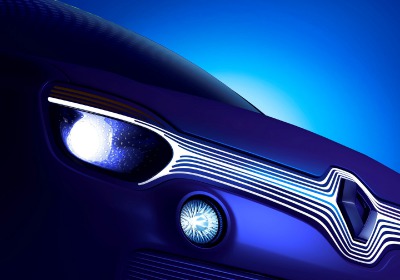First Sight: Twin’Z: Renault x Ross Lovegrove
Thu, 18 Apr 2013Among the many car brand-related unveils within Milan Design Week, Renault was the only marque to actually launch a fully-fledged concept car. Car Design News spoke exclusively to its technical project manager Minh Au Truong and design superstar collaborator Ross Lovegrove to find out more about this much-hyped vehicle.
When the news leaked that Renault would be teaming up with product design royalty Ross Lovegrove on a concept car to be revealed at Milan Design Week, to say this reviewer and the staff at Car Design News HQ were "a bit excited" would probably be an understatement. But did the reality match the hype?
Seeing the Twin'Z concept in the metal – or more accurately mostly carbon fibre and plastic – the short answer is a resounding yes. Sitting in a cove at the end of a large all-white room, otherwise empty except for a handful of extremely elegant (but somewhat ‘short stay') white and blue chairs by Ross Lovegrove, the car's setting was demonstrably ‘less-is-more'.
The Twin'Z concept – the fifth in design director Laurens van den Acker's lifecycle series since joining Renault and representative of ‘play' – matched that setting's feeling with a simple satin blue exterior color covering a compact conventional city car shape but one that indicates well-constructed proportions.
According to Renault's technical project manager Minh Au Truong, the concept is 80 to 90 percent true to the exterior of the next-generation Twingo due by early 2015, bar a couple of centimeters added to the concept's width and taken away from its roofline. The exterior is accented by wonderfully organic-shaped and bright yellow/green wheel caps, plus equally interesting nature-inspired detailing around the front grille and rear bumpers, aping wind flow or perhaps the ripple effect of wind on a sand dune. Alongside mulch-coloured, multi-dot LEDs built into the rear tailgate and panoramic roof and a clear rear spoiler and camera-based wing mirror housings, the exterior exudes a very light feeling.
It's an ambience mirrored inside the more conceptual cabin too, as Ross Lovegrove told CDN: "This concept is a reverse of the normal idea of a shiny exterior and a muted interior. With the blue paint finish we also wanted to express the electricity that underpins the car and the tactility and art value of the object with its soft-touch exterior feel."
Lovegrove had input in many areas of the car, but it's the interior that has seen most of his thinking come to the fore. Featuring bold blue, ultra-smooth surfacing, the IP, floor, door panels and rear parcel shelf all appear to be of a piece with gently undulating contours defined by a series of bright yellow lines. The conventional center console is dispensed with in favor of a portable slotted-in Samsung tablet, while the driver display is merely a smart phone housed in a bracket.
Continuing the organic theme, the four thin and lightweight carbon fiber chairs resemble bone-like structures with blue mesh stretched across them to create a see-through feeling that makes the cabin seem very open. The full-length panoramic roof adds to this feeling of airiness and its see-through graphic elements – visible from both the inside and from the outside – link the interior graphically and thematically to the exterior.
Judging by the admittedly anecdotal evidence of the hour and a half that CDN spent on the stand, the car was seen by a great number of people. No doubt helped by the familiarity of Lovegrove's name attached to the project it nonetheless seemed to receive a favorable reception from the design-savvy crowd, successfully vying for attention among the hundreds of other excellent examples of product design in the huge Triennale building within Milan Design Week. Lovegrove's name even graces the side of the concept – in what looked like a cheeky nod to go-faster stripes – and there was talk from both Renault and Lovegrove about the potential for a special Lovegrove edition of the production Twingo, a la Conran's highly sought-after limited run Nissan Cube.
For all the subtlety of the concept's design its name is a clumsy marketing own-goal though. Apparently the Twin'Z moniker indicates that it is one of two (another concept variant will show in May), while the first half of the word ‘Twingo' in its name is supposed to help inform viewers of the car it previews. But it is the ‘Z' at the end with the random apostrophe – to affirm its zero-emission powertrain – that grates most. Sounding like a long-forgotten West Coast rap duo with an inability or unwillingness to spell its name correctly, it's a minor blot on an otherwise excellent showcar.
Yes, we've seen some of its ideas on previous concepts, but the way all of the design elements have been brought together – by two very different design teams – has resulted in a superbly cohesive whole.
By Guy Bird

